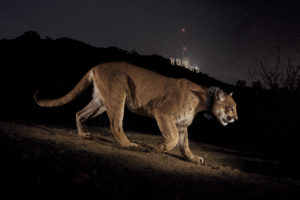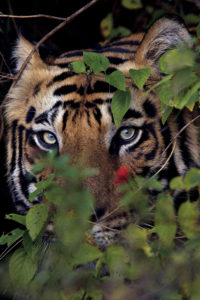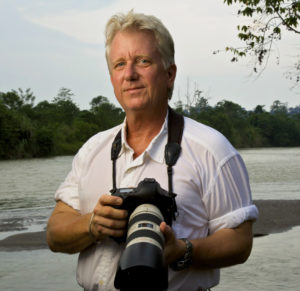
October 12, 2016
Enter the World of Big Cats with Nat Geo Photographer Steve Winter
We caught up with wildlife photojournalist Steve Winter, who is our guest for On the Trail of Big Cats, the first of four presentations in our new National Geographic Live speaker series, presented by the Houston Symphony, beginning October 25 at Jones Hall.
Your photography is stunning. Did you learn photography at the Academy of Art, or elsewhere? Also, who’s part of your photography team?
Most of my photography skills come from my father, starting when he bought my first camera at 7 years old. He really emphasized composition and looking at the masters of painting and lighting. In the field, I have an assistant and camera man. What I do is extremely complicated and time consuming regarding permits and various laws in countries all over the world.
How did you capture the photo of the mountain lion with the Hollywood sign in the background?
I thought, “Wouldn’t it be great to get a photograph of a mountain lion with the Hollywood sign?” All those cats in Santa Monica need to find their own territory. Eight months later, I received a text and a colleague said, “You’re not going to believe this, but a bobcat study

team has remote trail cams up in Griffith Park County and they got a photo of a mountain lion.” Then, my goal was to find out how to put remote cameras in downtown Los Angeles without them getting stolen and to find a location that would be perfect for that image. It took 15 months for me to get that photograph because the Hollywood sign is not lit. That was a 4-second exposure with a flash.
What is your favorite country for photographing big cats?
Any place that’s easy to work is my favorite. I love India because I’ve spent a lot of time there working on tigers. However, India is a bureaucratic nightmare and they don’t allow people to stay on past 3-4 years so it depends on the director of the reserve or national park at that time. I need a director that will work with me and allow me to place remote cameras that work 24/7 while I’m photographing for other stories.
Tell us the story of how you captured the photo of the tiger and her cub.
I spent 24 days – many of them atop an elephant – trying to get that photo. The cubs were so young and they were shy. The elephant was an anti-poaching patrol elephant with mahout (elephant rider). The tiger mother had grown up with that mahout and elephant and she was totally calm – she would lay right at the base of it and I would have to put my

Bandhavgarh Nat’l Park, India.
feet up because she could be sitting down there nursing for hours. For that photo, the cub tentatively got up and I put my eye to the camera with a 600 mm lens to get the shot, and when I looked up the cub was gone again. I was so stressed about waiting more than three weeks to get one picture that I didn’t look at the back of the cameras for two hours. The one perfect frame ended up being the cover of the Tigers Forever book.
What have you least expected in your work with National Geographic?
I was a photojournalist who didn’t take a photo of an animal until I was 34 years old, so I least expected working with animals. It just didn’t enter into my mind when I was in school at University of San Francisco in the Academy of Art program. I wanted to walk dusty village streets that had exotic cultures and people that really excited me as a kid, so I never in a million years thought I’d be a wildlife photographer. The fact that I’m the “big cat guy” now is amazing.
What breeds of cats are native to Texas? Have you photographed any?
You all have pumas and everyone talks about the jaguar that’s in Arizona, but I’m sure you have some jaguars that come over from Arizona and across the Mexican border. You also have ocelot, a small spotted cat, but pumas, cougars, bobcats and jaguarundi would be the dominant predators.
Can you discuss causes are you most passionate about?
Stopping the trade in tigers. We have three main problems with endangered species right now – trading rhino horns, elephant ivory and tiger bone. We have 5,000 tigers in the United States and there’s only 3,500 in the wild. Many of those tigers are in Texas kept by private individuals. China has tiger farms and they say, “Why should we do anything with

our tigers when you have as many in the states as we have?” They really have about 7-10,000. My wife and I had the Tiger Temple closed down, a tourism operation that was constantly accused of being part of the black market. It turns out they were. My wife never gave up and kept writing articles for Nat Geo, so the tiger temples were removed about 4 or 5 months ago. We actually have these animals for the future; there’s no way you can trade in tiger parts and not affect the wild population. Unfortunately, wild tiger bone and skins are often more valued than these farmed animals.
We read that you were once stalked by jaguars in Brazil. Can you talk a little about that memory?
I’ve been stalked by every big cat in the world! But that particular one was on the ranch where Teddy Roosevelt hunted jaguar in 1913. I went and saw the ranch because they said you could see a jaguar at dusk every day. There’s only one road on all these ranches because it’s the largest wetland in the world and in the distance I saw a jaguar. I got out of the pickup truck with a friend and we started walking, following this cat, and we got too close and when I looked up he was gone. That’s what jaguars do – if they see you, they will circle back around and he was sitting in the grass looking at us, waiting for us to come. When I finally saw him, he was only 12 feet away from me. I walked up a couple of steps closer to him so I could get his eyes looking at me through the tall grass. I couldn’t breathe, my heart was in my throat and the camera was shaking so badly I thought all of the photos would be blurry. But I got the opener to the first jaguar story in the history of National Geographic. That was incredible, but scary at the same time.
When I was doing my first Nat Geo history story, I was lying in bed one night and all of a sudden the stairs start creaking and I thought guys were coming to kill me. Then I heard

scratching and sniffing under the door and I’ve never been so scared in my life. I was there doing a story on a bird and that cat came to my door in a one-room shack on top of a mountain for one reason – I was the only person there and he just wanted to smell me. I whistled and that’s what got him to leave. I would walk back at night and all the hair on the back of my arms would stand up because we have a primeval part of our brains that knows we’re being stalked. I’d turn around and there was nothing there, but when I’d walk back, I’d see inside my tracks were the tracks of a jaguar. I called on the radio down the mountain and the naturalist said, “Oh, don’t worry; it’s just a black jaguar.” They didn’t want to scare me, but I saw it three weeks later when it actually came to where I was photographing. I marked my territory just like cats do and it went up the tree, bouncing across the branches. I didn’t get a photo of it.
What can audiences expect from your Big Cats presentation in Houston later this month?
The audience gets to go along with me in the field, see all these photographs I’ve taken and hear the stories behind them. I’ve had an incredible life doing something I’ve always wanted to do, even though my dream turned out completely different than what I thought it was going to be, which was photographing people. The lecture will have a lot of excitement, lots of laughs and take people on a great adventure that revolves around my experiences photographing jaguars, snow leopards, cougars and tigers.
Photos by Steve Winter






